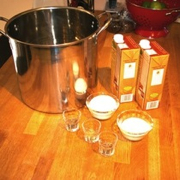Ingredients
- 2 quarts vegetable stock
- ½ cup salt (3/4 cup Kosher or coarse salt)
- ½ cup white sugar1 tablespoon dried rosemary
- 1 tablespoon dried sage
- 1 tablespoon dried thyme
- 2 quarts cold water
Directions
1. General Directions for brining a turkey: Before brining your turkey, check to make sure that it hasn't already been brined. Many turkeys these days are injected with a brine solution to add moisture. This includes kosher turkeys as well. Look for a turkey that is just a turkey with no other ingredients. These are frequently labeled as "natural". If you try to brine a bird with injected solutions, pre-brined, or packaged in a salty solution, you will end up with a turkey too salty to eat. |
2. To brine a turkey you will first need a large, nonreactive container. This could be plastic, glass or stainless steel. Other metal containers will react with the brine solution and give the turkey a metallic flavor. One great trick is to use a large, food safe sealable bag. Both Reynolds (Oven Roasting Bag for Turkeys) and Ziploc (XL Storage Bag) make very large food safe sealable bags that are great for brining. I prefer the Ziploc bags because they are stronger and less likely to be punctured. Place one of these bags in a large stock pot. This keeps everything together and makes clean-up easier. |
3. Next is knowing how much water you are going to need. To find this out, place the turkey, still in its packaging, in the container and fill the container with water. Yes, I know that the turkey is basically hollow so, add a few extra cups of water later when you do the math. Next, figure out how much water it will take so you know how much salt and sugar to add to the brine. |
4. Once the container is filled, take out the turkey and start measuring the water. As mentioned before, the cavity of the turkey is hollow and will need to be filled as well. For a turkey under 16 pounds add two cups of water to your measurement. For a turkey over 16 pounds add three cups. This should be enough. It is important that the whole turkey is completely submerged in water, so make sure you have an inch or two at the top, above the bird. |
5. Once you have measured how much water you need, write it down. I can't tell you how many times I have forgotten the number when it came time to fill the container and had to start from scratch. |
6. Now it is time to do the math. You need 1 cup of table salt per gallon of water to get a proper brine. This works out to 1 tablespoon of salt per cup of water (16 cups in a gallon, 16 tablespoons in a cup). Make sure you are not using salt with iodine. Iodine will spoil the flavor. Not all salt is created equally (see my article on salt). If you are using kosher salt you need to add twice as much salt since it is larger in crystal and lighter by volume. If you want accuracy, weigh the salt. You want 10 ounces by weight of salt per gallon of water. |
7. Combine all the ingredients for your brine in a large pot and bring the whole mixture to a near boil. However, you will need to cool the brine before placing the turkey in it. The brine needs to be cold, very cold to prevent the turkey from spoiling in the brine. |
8. Place brine into a container with the turkey, making sure the bring covers the turkey completely, and place a bag full of ice over the turkey to hold it down. |
9. Let the turkey brine for 1 hour per pound. |
10. Rinse the turkey thoroughly before you do anything with it. If you don't, you'll be sorry. |
11. Brine Recipe: In a large pot combine vegetable stock, salt, sugar, and herbs over a medium heat. Simmer for about 15 minutes until the salt is completely dissolved. Remove from heat and allow to cool. Add cold water. |
12. Place turkey in a large plastic container. Pour brine over top, cover and refrigerate. Brine for 1 hour per pound. |
13. Thoroughly rinse all the brine from the turkey before cooking. Otherwise there will be a salty flavor to the turkey. For a more detailed explanation, see my article on brining turkey. |
 Savory Turkey Brine. To import, drag image to your MacGourmet recipe box.
Savory Turkey Brine. To import, drag image to your MacGourmet recipe box.
